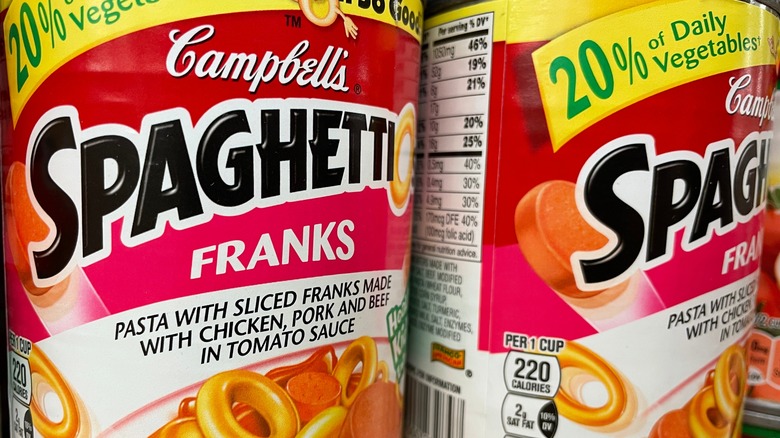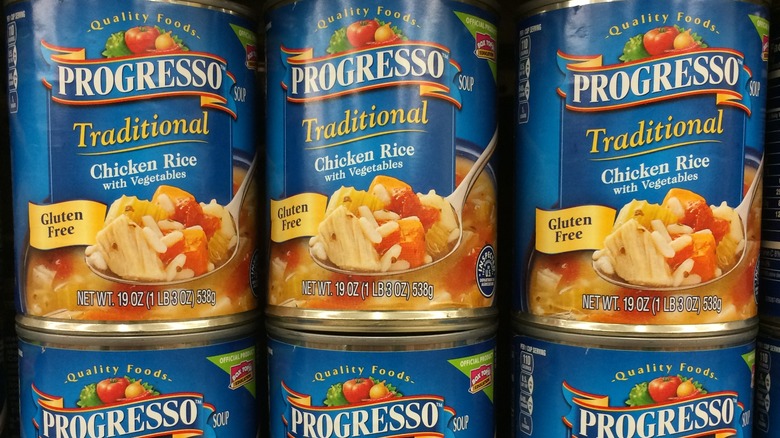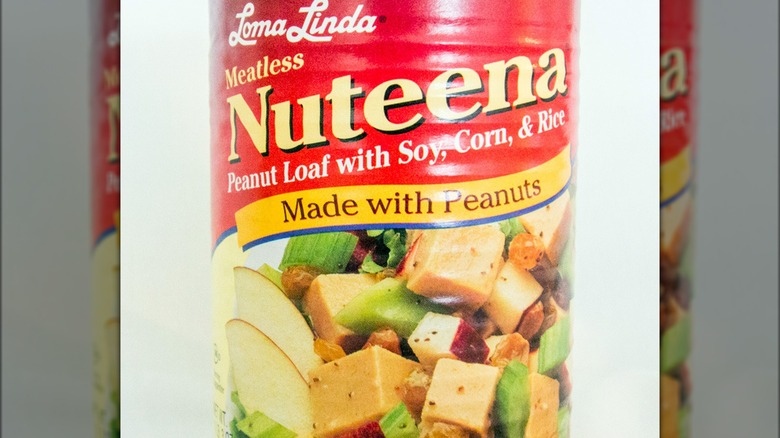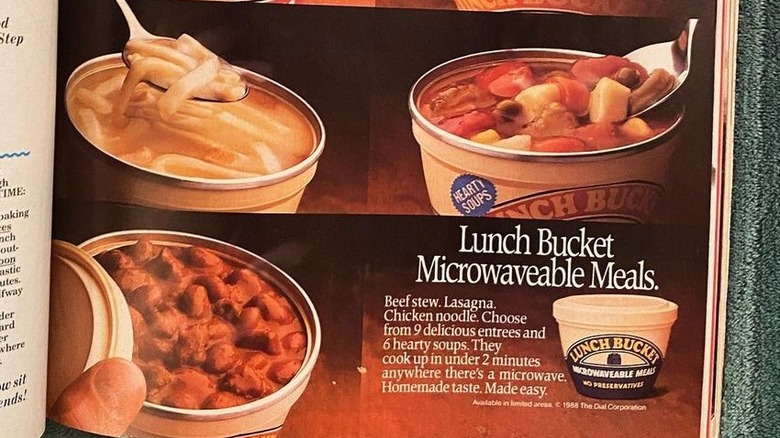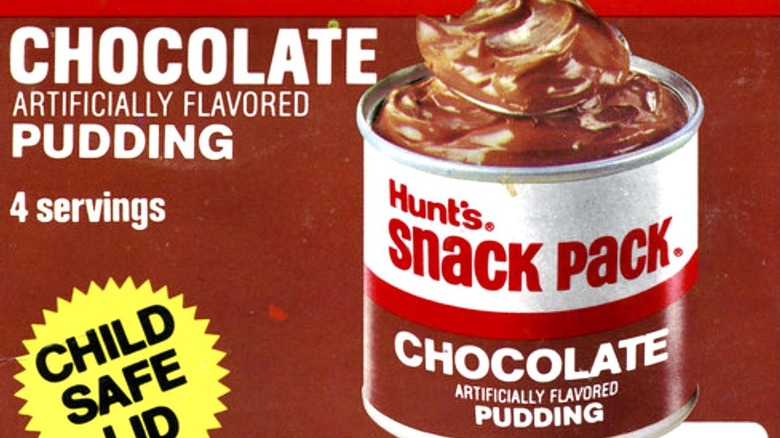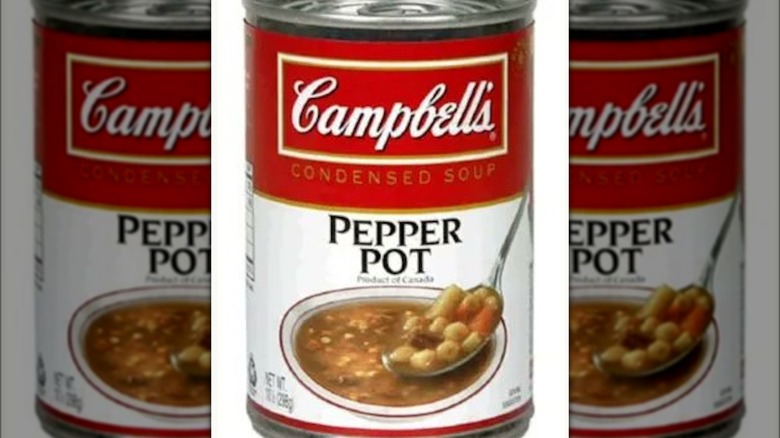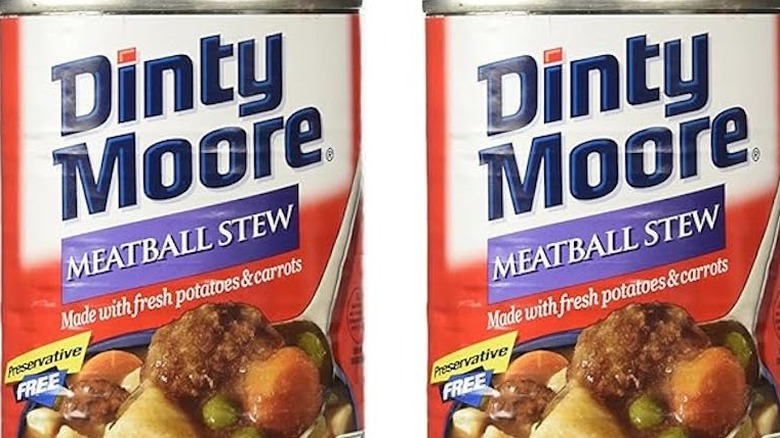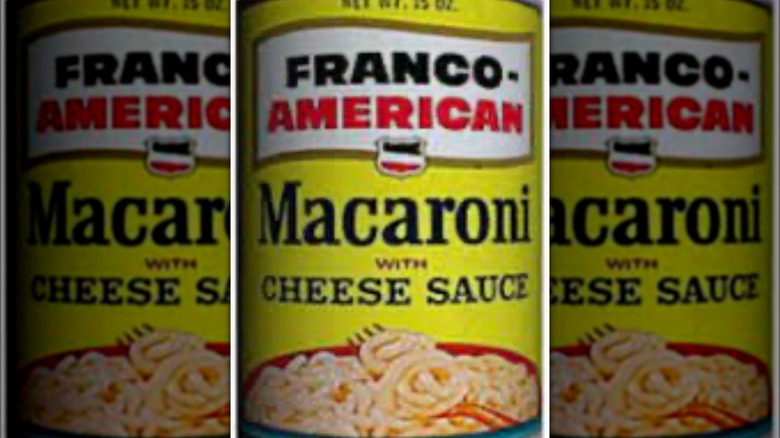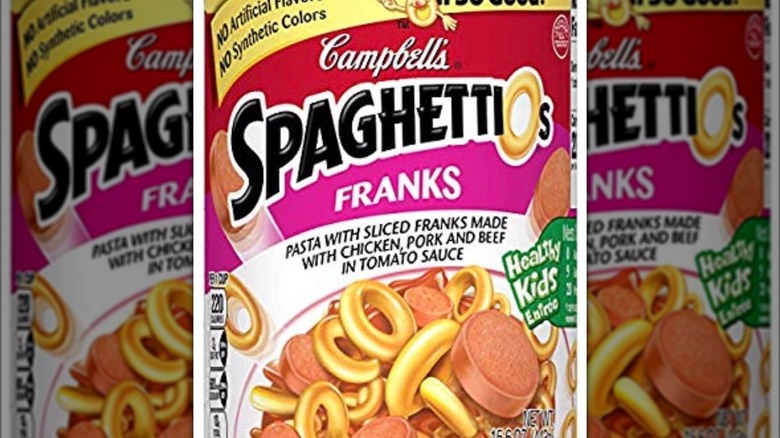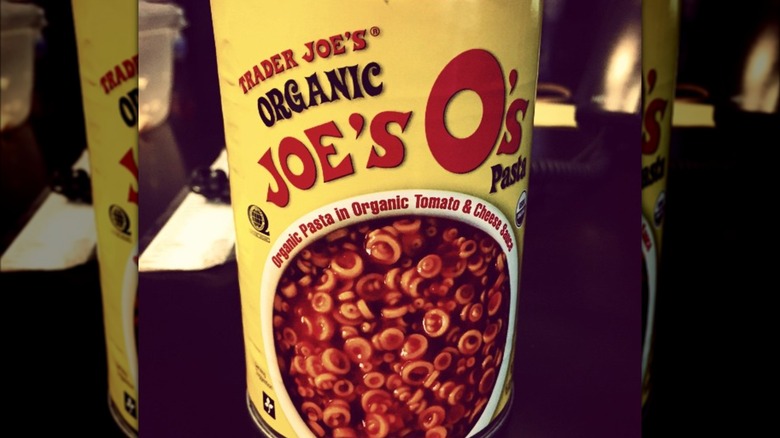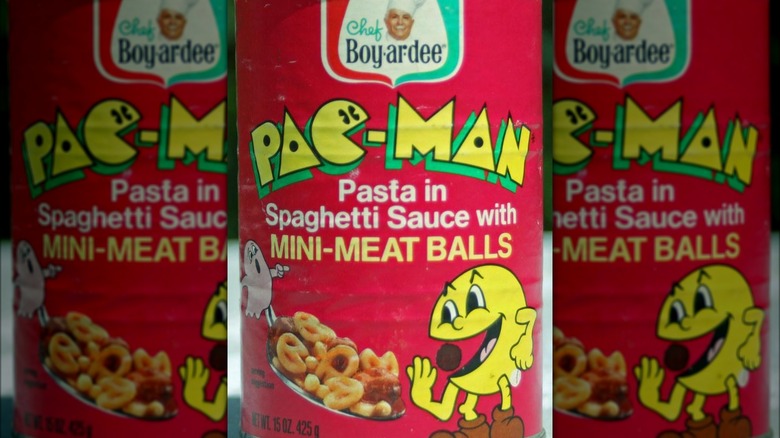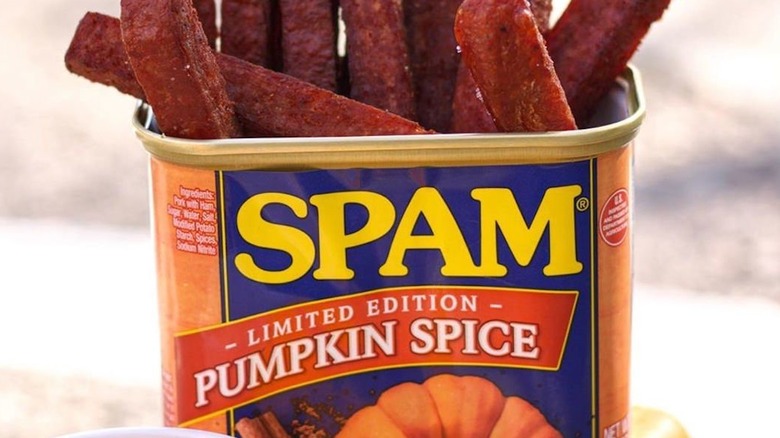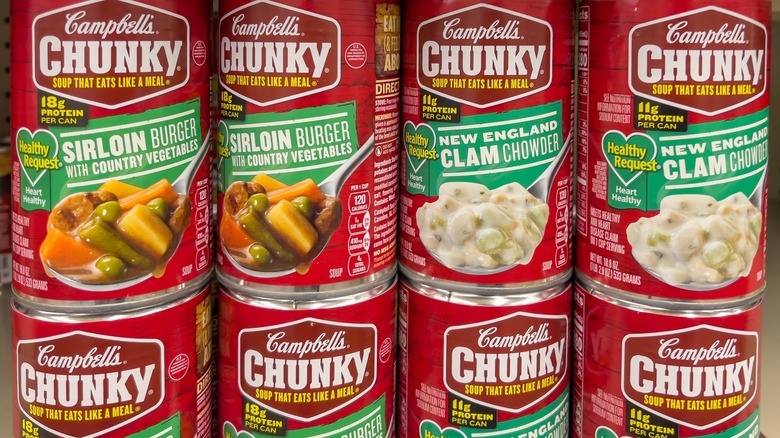Discontinued Canned Foods We Miss The Most
We may receive a commission on purchases made from links.
Canned goods are a modern marvel and a triumph of food science. The technology allowed otherwise perishable food to be preserved and shipped indefinitely, and brought about the rise of many food conglomerates who made it their business to help the world stock its pantries with canned goods. Foods packed tightly into an aluminum can are great in a pinch or as the star of a meal, either as a flavorful and inexpensive ingredient or as a main course. With some foods, canned versions are sometimes just as good as homemade, and that helped them become staples of the pantry. Many canned products can hang around shelves for years on end, called upon when needed, easily replenished with a trip to the average supermarket.
Canned goods is a sector where generic groceries are the ones Americans are buying most, but brand-name items still loom large. And that's when the big food distributors get involved. Corporate business plans change, and so do the collective tastes of the public. The customers' needs and relationships with canned and convenience foods ebb and flow, making canned goods a relatively volatile space, with foods moving in and out of the realm all the time, including products beloved by a great many people. Here are the once popular and vital canned foods that have been discontinued and which we'll likely never get to eat again.
Dozens of Progresso Soups
With origins in 19th century Italy and an early American history spent canning Italian foods in the United States, Progresso evolved into a canned soup company by the 1940s and became the first packager of minestrone, split pea, and lentil soup. Pillsbury bought Progresso in 1969, and in 2001 it became a brand controlled by food mega-conglomerate General Foods. And as Progresso once gave Americans so many soups, it could take them away, too. By 2020, the Progresso line of premium canned soups numbered about 90 varieties, which executives decided was way too many.
As Americans spent much of 2020 living under lockdown in efforts to stop or slow the spread of COVID-19, their eating and shopping habits changed. Americans cooked at home more and purchased larger quantities of comfort foods, like General Mills' Betty Crocker cake mixes and several of its Progresso soups.
In the early months of the pandemic, General Mills decided to end production on 40 of those soups. Among the Progresso soups lost, possibly forever, during this pandemic-era cost-cutting endeavor: chicken cheese enchilada, chicken & orzo with lemon, multiple chicken noodle variants, and green pea. The company could refocus its resources on producing, promoting, and stocking the soups that did sell well while also getting better equipped to stock the product into non-grocery retail outlets with less available shelf space. The reason: Shoppers ditched their primary grocery stores in favor of alternatives.
Nuteena
Before vegetarianism became a mainstream lifestyle in the 1970s and beyond, those who eschewed animal products for health or moral reasons didn't have many options. Food makers had only started to develop many protein-rich, plant-based meat alternatives. One such product came from a group you might not expect:The Seventh-day Adventists, a sect of Christianity, have espoused a vegetarian diet since the 19th century. Members of the church helped bring to the market vegetarian, meat-like products through the brand Loma Linda.
Beginning in the 1960s, Loma Linda started making a canned protein substitute called Nuteena. A thick, beige loaf with a tofu-like consistency, Nuteena was entirely plant-based. It was made primarily from peanut paste, as well as soy, corn, and rice, all based on a recipe devised in the 1890s by health food advocate and early vegetarianism advocate John Harvey Kellogg. Nuteena was a versatile food and standard pantry item for vegetarians, as it could be cooked or served raw, cut up into slices or used as a spread.
In the 21st century, plant-based meats are a big business, even if companies can't yet quite make hamburgers or hot dogs that can't quite measure up to the real thing. But vegetarians and vegans do have a lot more choices than they used to, meaning the demand for Nuteena has dropped off. Loma Linda stopped making its once-flagship nut loaf in 2005.
Lunch Bucket
Evoking both highbrow and lowbrow imagery in its marketing, Lunch Bucket took its name from an old-fashioned style of working man's lunch box but used a fancy British-accented butler as its spokes-mascot, whipping out a white tablecloth to present the line of individually portioned microwavable meals. Akin to a frozen dinner but sold and heated up in its specially made, metal-tipped plastic can, Lunch Bucket hit the market in 1989 in 16 different varieties, including lasagna, beef stew, and in various soups, pastas, and re-creations of home cooking and comfort food favorites. It was one of many products designed to capitalize on the 1980s biggest cooking appliance fad: the widespread adoption of the microwave. Lunch Bucket meals were as convenient as they were tasty, as they took less than a minute to heat up to serving temperature.
Hearty, shelf-stable meals that were easy to transport, the Lunch Bucket line lasted well into the 1990s. Other food companies adopted the packaging and heating vessel that contained a Lunch Bucket meal, particularly Chef Boyardee and Campbell's pasta lines but the canned meals, initially introduced by soap company Dial, left stores in the mid-1990s.
Snack Pack pudding in aluminum cans
Today, pudding is probably most commonly considered a convenience food. Purchased as a boxed powder and requiring the addition of milk, or sold pre-made in small plastic cups out of grocery stores' refrigerated areas or snack shelves, one can enjoy chocolate, vanilla, or butterscotch pudding in mere moments. Until the arrival of those products, such as the first boxed pudding mix in 1916, if one wanted pudding, they had to make it from scratch.
The first shelf-stable, ready-to-eat pudding debuted in 1968 in the form of Hunt's Snack Pack. Made with in-house-developed technology to prevent the dairy-based, non-refrigerated treat from spoiling, Snack Pack pudding — available in flavors like chocolate fudge and butterscotch — came tightly packed into small, squat metal cans. To enjoy, one simply peeled back the thin metal top, and dug in, all while heeding the packaging's warning to not get cut by the sharp aluminum disposable lid or the edge of the pudding container.
Snack Pack moved to the safer but cheaper option of stuffing pudding into plastic cups in 1984, ending the era of the tasty pudding in metal cans. While the recipe hasn't much changed — Snack Pack is still made with real milk and real sugar, not high fructose corn syrup — it's just not the same snacking experience.
Campbell's Pepper Pot soup
Campbell's rolled out the Pepper Pot variety in 1899, and it stood out from the company's line of mildly spiced, similar-tasting canned soups. With a thick and hearty consistency more akin to a stew, and containing potatoes, onions, carrots, bacon, beef tripe, and two heat sources — jalapeño pepper and red pepper flakes — the soup was based on a Philadelphia favorite, introduced to the area by immigrants from the Caribbean and West Africa.
Pepper Pot remained in production for more than a century, building a relatively small but consistent customer base with the soup that represented one of the few widely available packaged versions of Caribbean food. It was never a huge seller, and demand for the very old-fashioned soup declined in the 21st century to the point where Campbell's stopped making it altogether in 2010. Fans have lobbied Campbell's to reinstate the old favorite as late as 2023, but the company hasn't revived Pepper Pot.
Dinty Moore Meatball Stew
Dinty Moore is among the many name brands produced and distributed by Hormel. tThe company first made a canned mixture of beef, vegetables, and gravy in 1935 called Dinty Moore beef stew. This particular "Dinty Moore" wasn't a real person — Hormel jumped onto the popularity of the early 20th century comic strip "Bringing Up Father," also known as "Jiggs and Maggie," which concerned a man who hung out at Dinty Moore's diner eating homestyle dishes like corned beef and beef stew. A string of real restaurants called Dinty Moore opened in New York and attracted so many customers that Hormel decided to create a line of canned stews named after the same fictional cartoon character.
Nearly 90 years later, with the "Bringing Up Father" connection mostly forgotten, Dinty Moore stews remain ubiquitous in grocery stores and where canned goods may safely languish. But only the original Dinty Moore beef stew and a chicken and dumplings variety are still available in the 2020s. Dinty Moore meatball stew, essentially the beef stew but with balls of mostly ground beef substituted in for intact meat chunks, is no longer produced. Sold for decades, it never took off the way the beef stew did, and Hormel ended production sometime in the mid-2010s. Along with generously apportioned meatballs, the can contained fresh potatoes, cubed soft, and succulent carrots as well as peas.
Franco-American Macaroni and Cheese
Franco-American started out as a French immigrant-founded, New Jersey-based canned pasta and soup company, before it was acquired by its much larger competitor, Campbell Soup, in 1915. Campbell's would continue to use the Franco-American brand name for many of its subsidiary's offerings for decades, including its perennially successful line of canned pastas, headlined by SpaghettiOs, a canned spaghetti and meat sauce product, and macaroni with cheese sauce. Popular concurrently with and in spite of the rise of Kraft's boxed macaroni and cheese dinner, Franco-American's version was a far different product, more akin to spaghetti noodles (not even elbow macaroni) swimming in a cheesy, buttery sauce.
Not counting a break during World War II, Campbell Soup manufactured and distributed the canned macaroni and cheese variant, and under the Franco-American name, from 1939 all the way until 2004. That year, it eliminated the Franco-American brand entirely. From that point on, SpaghettiOs have fallen under the purview of the Campbell's label, while the macaroni with cheese sauce, which also adopted the new corporate moniker, was phased out.
SpaghettiOs with Franks
Created by Campbell's Soup marketing head Donald Goerke under its Franco-American label, SpaghettiOs were touted as a way to serve spaghetti quickly and with little fuss. Ads called it "the neat round spaghetti you can eat with a spoon," and gave the product the memorable, sung slogan, "Uh-oh, SpaghettiOs."
Since the introduction of regular, plain noodles-and-sweetened tomato sauce in cans in 1965, Campbell's — it eliminated the Franco-American distinction altogether in 2004 — has unveiled numerous versions of SpaghettiOs with extra flavors and additional proteins to bulk it up. Among those are mixed-meat balls, a kind made with Frank's Red Hot Sauce, and one with tiny sliced pieces of hot dogs, or wieners, officially known as SpaghettiOs with Franks. Campbell's quietly stopped manufacturing and producing cans of the kid-friendly all-in-one spaghetti and hot dog dinner in 2023, as confirmed by the petitioners at Change.Org, who have already set out on a campaign to revive the product. At the moment, Campbell's has kept SpaghettiOs with Franks off the production line, however.
Trader Joe's Organic Joe's O's
Trader Joe's canned goods are always good to have in the pantry, especially if the grocery store chain decides to abruptly stop selling certain long-standing products. Regular, original-style, unadorned SpaghettiOs were such an instant and perennial bestseller that food producers besides Campbell's wanted in on the financial bonanza. Bite-size noodle rings in tomato sauce is a very easy premise to replicate, and numerous imitations, generic, and private-label versions have hit store shelves over the decades. Among the more popular and innovative of all those not-quite-SpaghettiOs was Trader Joe's O's.
The 500-odd chain of small, organic and natural-foods-focused supermarkets stocks its shelves almost entirely with private brands, contracting with significant food manufacturers to make the products that bear the Trader Joe's name. Among its self-named products were Trader Joe's Organic Joe's O's, which looked a lot like SpaghettiOs and came in a can like SpaghettiOs, but unlike Spaghetti)s, were made of USDA-certified organic ingredients. Trader Joe's routinely moves in new products, removing older ones to make space. That seems to be the case with Trader Joe's Organic Joe's O's, which were discontinued without notice or prior announcement in 2021.
Fleeting pastas from Chef Boyardee
As it has for decades, Chef Boyardee sells many varieties of heat-and-eat canned pasta meals. Consisting of noodles, sauce, and maybe meatballs, pretty much the same ingredients and flavors recur throughout every Chef Boyardee product, although the brand will occasionally introduce something new, with the pasta shaped in a fun, interesting, and kid-friendly manner. In the mid-1970s, Roller Coasters became one of the first novelty Chef Boyardee entries. The pasta wasn't shaped like roller coaster cars, but suggested the nature of the amusement park ride's tracks, all twisty and spiraled. "They're wavy like roller coasters. They're fun like roller coasters," a commercial at the time explained.
In 1982, Chef Boyardee released Cosmic Kids, "a new fun lunch that tastes out of this world," according to a print ad. Available meatless or with meatballs or chicken, the pasta vaguely resembled the shapes of the juvenile aliens and robots depicted on the can. The style disappeared by 1986, lasting until the gimmick wore off and public interest waned, something that also happened with some faddish, pop culture-oriented styles. Pac-Man and the Smurfs were phenomenally popular in the 1980s, and so, too were Chef Boyardee's not-forever-available canned pasta products shaped like characters from the video game and the Saturday morning cartoon, respectively.
Various flavors of Spam
Easily one of the most joked about foods — it's a gelatin-coated brick of preserved pink meat, after all — Spam nevertheless is one of the most successful canned goods ever made. Since its introduction by Hormel in 1937 as a nonperishable, inexpensive protein that used up a mass quantity of otherwise unmarketable pork shoulder, eight billion cans of the stuff have been sold. But Spam isn't just one thing — it's a whole line of flavors and varieties.
In the fall of 2019, Hormel braved a new frontier in the place where sweet meets savory while also catering to a major cultural trend. Pumpkin spice items are a seasonal Frankenstein, and pumpkin spice Spam joined the fray. Marketed as a limited-time-only offering, and purportedly produced in modest batches, the autumnal Spam went up for sale only on Spam.com and via Walmart's online store. Spam fans, curious to see what the heavily processed and highly salty pork-and-ham mixture would taste like with the addition of allspice, nutmeg, clove, and cinnamon, bought up the whole production run in about seven hours. But then pumpkin spice Spam went away, joining many other Spam styles that briefly appeared on store shelves but which couldn't gain a foothold with consumers and which Hormel stopped making. Among the lost types of Spam: chorizo, garlic, black pepper, Portuguese sausage, and cheese.
A few flavors of Campbell's Chunky soups
After trying and failing with Campbell's Stout Hearted Soups, a late 1960s collection of densely caloric offerings, the Campbell Soup Company took another try in 1970 with Campbell's Chunky Soup. Different from the standard small cans of liquid-forward Campbell's soups, Chunky was sold in extra-large cans and marketed to consumers with big appetites, promising plentiful portions of big meat chunks and lots of vegetables. The product didn't really become a household name until 1997, when Campbell's launched an football-themed ad campaign, enlisting NFL stars as pitchmen to promote "The soup that eats like a meal."
Many Chunky styles have moved out of the lineup over the decades, including the original four varieties, Chunky Beef, Chunky Vegetable, Chunky Turkey, and Chunky Chicken. Over the past decade, Campbell's has added lots of new flavors, like Nashville-style hot chicken and Texas-style BBQ burger, at the expense of others. Around 2017, Campbell's got rid of Chunky Philly-style cheesesteak, and four years later, stopped making Meatball Bustin' Sausage and Rigatoni. While those deletions were latter-day additions to the line, one of the brand's longest-lasting soups was discontinued in 2023: Chunky chicken mushroom chowder, sold in stores since the 1970s.
